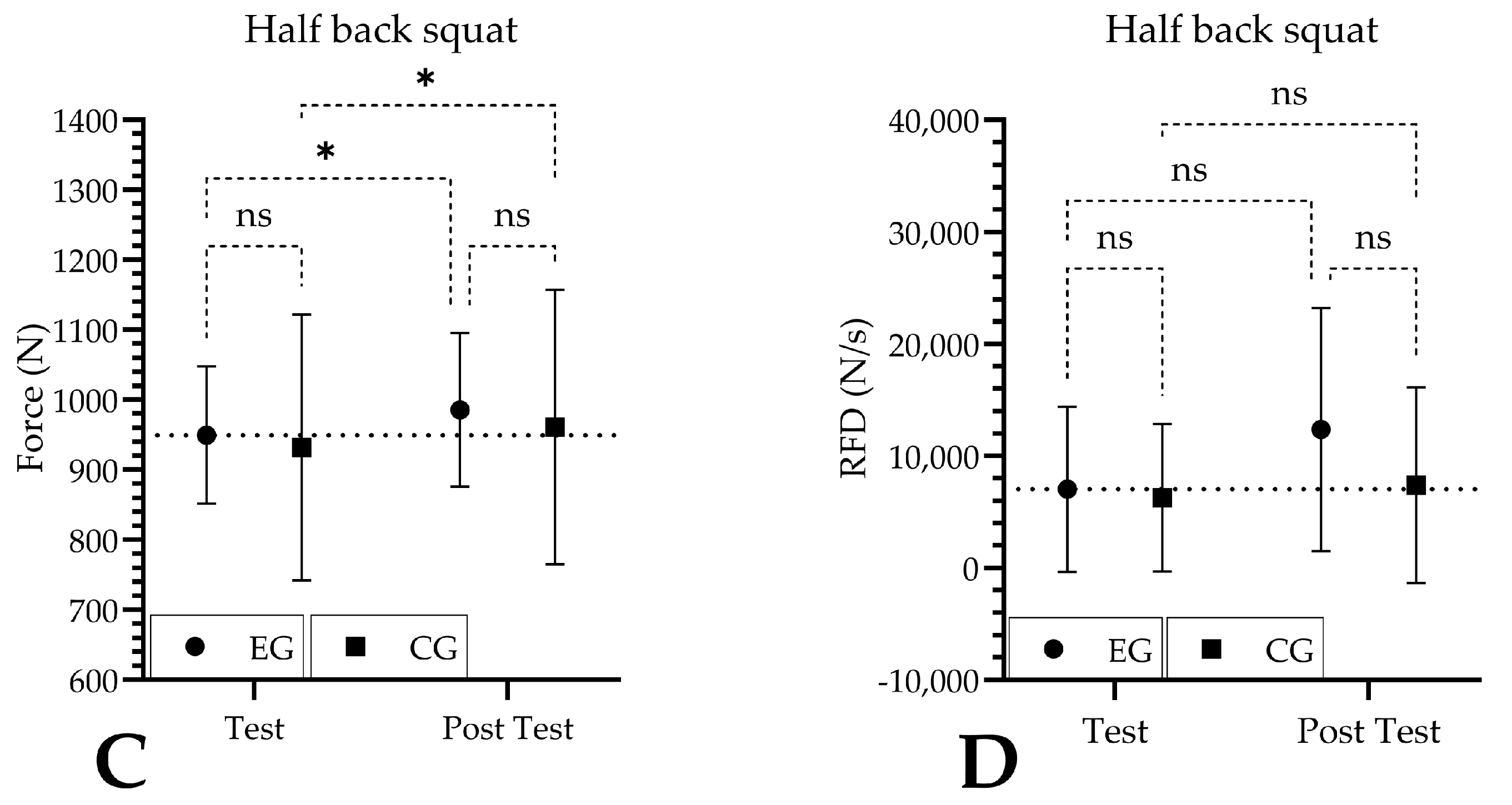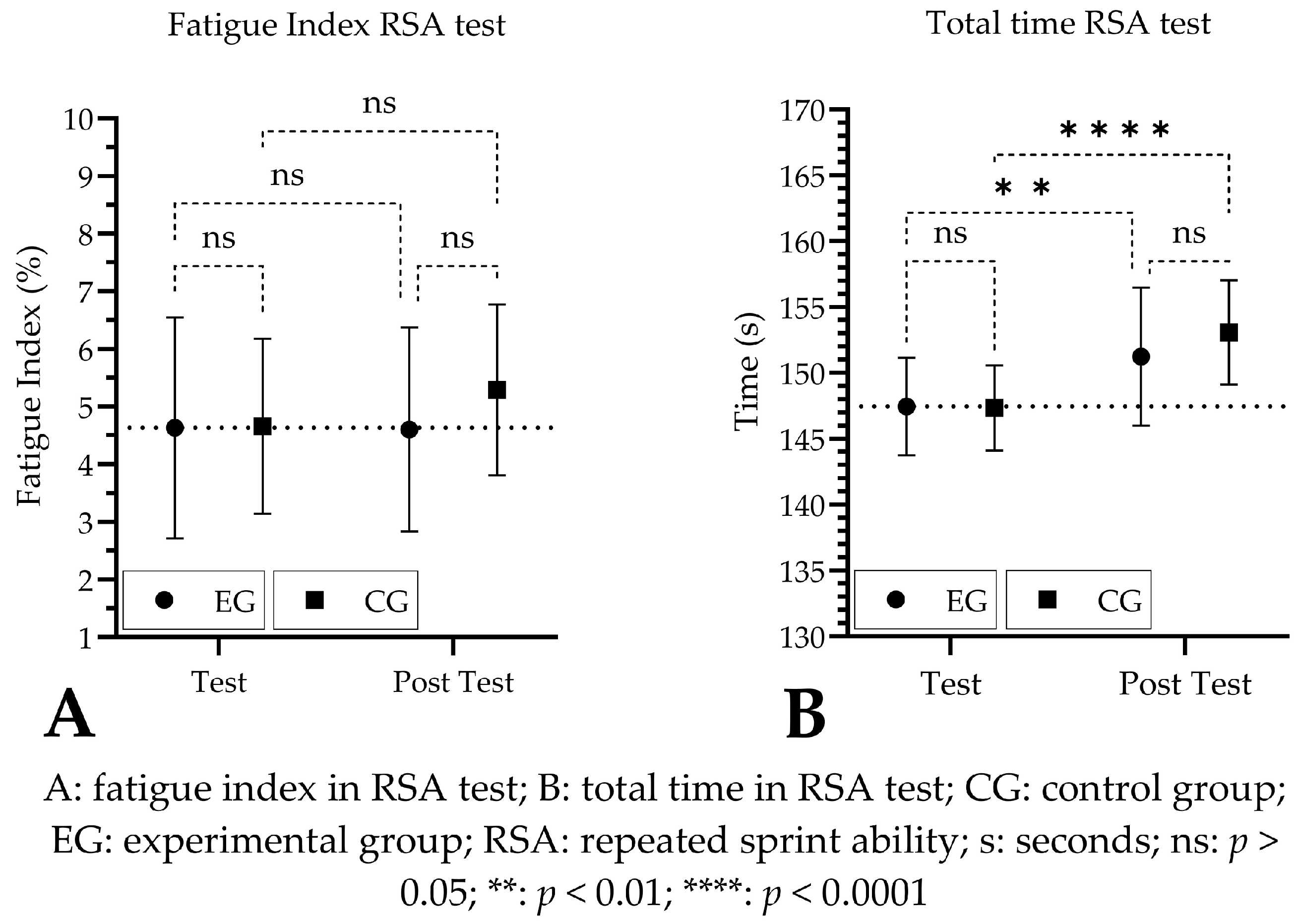Effects of a Low Dose of Orally Administered Creatine Monohydrate on Post-Fatigue Muscle Power in Young Soccer Players
Abstract
1. Introduction
2. Materials and Methods
2.1. Design
2.2. Participants
2.3. Anthropometry
2.4. Warm-Up Protocol
2.5. 1RM Test
2.6. RSA Test
2.7. Muscle Power Development after Fatigue Induction
2.8. Supplementation
2.9. Statistical Analysis
3. Results
4. Discussion
4.1. Muscle Strength and Power Production after Creatine Intake
4.2. Fatigue Induction during High-Intensity Intermittent Exertion
4.3. Limitations
5. Conclusions
6. Practical Applications
Supplementary Materials
Author Contributions
Funding
Institutional Review Board Statement
Informed Consent Statement
Data Availability Statement
Acknowledgments
Conflicts of Interest
References
- Kyles, A.; Oliver, J.L.; Cahill, M.J.; Lloyd, R.S.; Pedley, J. Linear and Change of Direction Repeated Sprint Ability Tests: A Systematic Review. J. Strength Cond. Res. 2023, 37, 1703–1717. [Google Scholar] [CrossRef]
- Sosa-Izquierdo, J.J.; Salas-Sánchez, J.; Latorre-Román, P.Á. Caracterización Del Entrenamiento de La Fuerza En Futbolistas Profesionales y Semi-Profesionales de Las Ligas Españolas [Characterization of Strength Training in Professional and Semi-Professional Soccer Players in Spanish Leagues]. Retos 2024, 53, 453–460. [Google Scholar] [CrossRef]
- Nédélec, M.; McCall, A.; Carling, C.; Legall, F.; Berthoin, S.; Dupont, G. Recovery in Soccer: Part I—Post-Match Fatigue and Time Course of Recovery. Sports Med. 2012, 42, 997–1015. [Google Scholar] [CrossRef] [PubMed]
- Ramírez, J.M.; Núñez, V.M.; Lancho, C.; Poblador, M.S.; Lancho, J.L. Velocity-Based Training of Lower Limb to Improve Absolute and Relative Power Outputs in Concentric Phase of Half-Squat in Soccer Players. J. Strength Cond. Res. 2015, 29, 3084–3088. [Google Scholar] [CrossRef]
- Thomakos, P.; Spyrou, K.; Katsikas, C.; Geladas, N.D.; Bogdanis, G.C. Effects of Concurrent High-Intensity and Strength Training on Muscle Power and Aerobic Performance in Young Soccer Players during the Pre-Season. Sports 2023, 11, 59. [Google Scholar] [CrossRef]
- Allen, D.G.; Lamb, G.D.; Westerblad, H. Skeletal Muscle Fatigue: Cellular Mechanisms. Physiol. Rev. 2008, 88, 287–332. [Google Scholar] [CrossRef] [PubMed]
- Bigland-Ritchie, B.; Woods, J.J. Changes in Muscle Contractile Properties and Neural Control during Human Muscular Fatigue. Muscle Nerve 1984, 7, 691–699. [Google Scholar] [CrossRef]
- Smith, M.R.; Coutts, A.J.; Merlini, M.; Deprez, D.; Lenoir, M.; Marcora, S.M. Mental Fatigue Impairs Soccer-Specific Physical and Technical Performance. Med. Sci. Sports Exerc. 2016, 48, 267–276. [Google Scholar] [CrossRef]
- Barte, J.C.M.; Nieuwenhuys, A.; Geurts, S.A.E.; Kompier, M.A.J. Effects of Fatigue on Interception Decisions in Soccer. Int. J. Sport Exerc. Psychol. 2020, 18, 64–75. [Google Scholar] [CrossRef]
- Nedelec, M.; Wisloff, U.; McCall, A.; Berthoin, S.; Dupont, G. Recovery after an Intermittent Test. Int. J. Sports Med. 2013, 34, 554–558. [Google Scholar] [CrossRef]
- Barbero-Álvarez, J.C.; Pedro, R.E.; Nakamura, F.Y. Validity of a Repeated-Sprint Ability Test in Young Soccer Players. Sci. Sports 2013, 28, e127–e131. [Google Scholar] [CrossRef]
- e Silva, T.M.; Abreu, W.C.; Pimenta, E.; da Silva, S.F. Effects of Caffeine Supplementation on the Recovery of Professional Soccer Players. Muscles 2023, 2, 1–11. [Google Scholar] [CrossRef]
- Kreider, R.B.; Wilborn, C.D.; Taylor, L.; Campbell, B.; Almada, A.L.; Collins, R.; Cooke, M.; Earnest, C.P.; Greenwood, M.; Kalman, D.S.; et al. ISSN Exercise and Sport Nutrition Review: Research and Recommendations. J. Int. Soc. Sports Nutr. 2010, 7, 7. [Google Scholar] [CrossRef]
- Kerksick, C.M.; Wilborn, C.D.; Roberts, M.D.; Smith-Ryan, A.; Kleiner, S.M.; Jäger, R.; Collins, R.; Cooke, M.; Davis, J.N.; Galvan, E.; et al. ISSN Exercise & Sports Nutrition Review Update: Research & Recommendations. J. Int. Soc. Sports Nutr. 2018, 15, 38. [Google Scholar] [PubMed]
- Trexler, E.T.; Smith-Ryan, A.E. Creatine and Caffeine: Considerations for Concurrent Supplementation. Int. J. Sport. Nutr. Exerc. Metab. 2015, 25, 607–623. [Google Scholar] [CrossRef] [PubMed]
- Jäger, R.; Purpura, M.; Shao, A.; Inoue, T.; Kreider, R.B. Analysis of the Efficacy, Safety, and Regulatory Status of Novel Forms of Creatine. Amino Acids 2011, 40, 1369–1383. [Google Scholar] [CrossRef] [PubMed]
- Wax, B.; Kerksick, C.M.; Jagim, A.R.; Mayo, J.J.; Lyons, B.C.; Kreider, R.B. Creatine for Exercise and Sports Performance, with Recovery Considerations for Healthy Populations. Nutrients 2021, 13, 1915. [Google Scholar] [CrossRef]
- Antonio, J.; Candow, D.G.; Forbes, S.C.; Gualano, B.; Jagim, A.R.; Kreider, R.B.; Rawson, E.S.; Smith-Ryan, A.E.; VanDusseldorp, T.A.; Willoughby, D.S.; et al. Common Questions and Misconceptions about Creatine Supplementation: What Does the Scientific Evidence Really Show? J. Int. Soc. Sports Nutr. 2021, 18, 13. [Google Scholar] [CrossRef]
- Kreider, R.B.; Kalman, D.S.; Antonio, J.; Ziegenfuss, T.N.; Wildman, R.; Collins, R.; Candow, D.G.; Kleiner, S.M.; Almada, A.L.; Lopez, H.L. International Society of Sports Nutrition Position Stand: Safety and Efficacy of Creatine Supplementation in Exercise, Sport, and Medicine. J. Int. Soc. Sports Nutr. 2017, 14, 18. [Google Scholar] [CrossRef]
- Guevara, V.M.; Montalva-Valenzuela, F.; Andrades-Ramírez, O.; Vargas, J.J.N.; Flores, I.; Castillo-Paredes, A. Futbol y Creatina, Una Revisión Sistemática [Soccer and Creatine, a Systematic Review]. Retos 2024, 51, 763–770. [Google Scholar] [CrossRef]
- Mielgo-Ayuso, J.; Calleja-Gonzalez, J.; Marqués-Jiménez, D.; Caballero-García, A.; Córdova, A.; Fernández-Lázaro, D. Effects of Creatine Supplementation on Athletic Performance in Soccer Players: A Systematic Review and Meta-Analysis. Nutrients 2019, 11, 757. [Google Scholar] [CrossRef] [PubMed]
- Yáñez-Silva, A.; Buzzachera, C.F.; Piçarro, I.D.C.; Januario, R.S.B.; Ferreira, L.H.B.; McAnulty, S.R.; Utter, A.C.; Souza-Junior, T.P. Effect of Low Dose, Short-Term Creatine Supplementation on Muscle Power Output in Elite Youth Soccer Players. J. Int. Soc. Sports Nutr. 2017, 14, 5. [Google Scholar] [CrossRef] [PubMed]
- Kreider, R.B.; Stout, J.R. Creatine in Health and Disease. Nutrients 2021, 13, 447. [Google Scholar] [CrossRef]
- Ato, M.; López, J.J.; Benavente, A. A Classification System for Research Designs in Psychology. An. Psicol. 2013, 29, 1038–1059. [Google Scholar] [CrossRef]
- McKay, A.K.A.; Stellingwerff, T.; Smith, E.S.; Martin, D.T.; Mujika, I.; Goosey-Tolfrey, V.L.; Sheppard, J.; Burke, L.M. Defining Training and Performance Caliber: A Participant Classification Framework. Int. J. Sports Physiol. Perform. 2022, 17, 317–331. [Google Scholar] [CrossRef]
- Harriss, D.J.; MacSween, A.; Atkinson, G. Ethical Standards in Sport and Exercise Science Research: 2020 Update. Int. J. Sports Med. 2019, 40, 813–817. [Google Scholar] [CrossRef]
- McNair, P.J.; Depledge, J.; Brettkelly, M.; Stanley, S.N. Verbal Encouragement: Effects on Maximum Effort Voluntary Muscle Action. Br. J. Sports Med. 1996, 30, 243–245. [Google Scholar] [CrossRef]
- Sanchez-Medina, L.; Perez, C.E.; Gonzalez-Badillo, J.J. Importance of the Propulsive Phase in Strength Assessment. Int. J. Sports Med. 2010, 31, 123–129. [Google Scholar] [CrossRef]
- Chaouachi, A.; Manzi, V.; Wong, D.P.; Chaalali, A.; Laurencelle, L.; Chamari, K.; Castagna, C. Intermittent Endurance and Repeated Sprint Ability in Soccer Players. J. Strength Cond. Res. 2010, 24, 2663–2669. [Google Scholar] [CrossRef]
- Perroni, F.; Corvino, M.; Cignitti, L.; Minganti, C. RSA Response to Preseason Training in Semiprofessional Soccer Players. Sport Sci. Health 2013, 9, 59–64. [Google Scholar] [CrossRef]
- Jorge, G.; Garrafoli, M.T.; Cal Abad, C.C. Seasonal Repeated Sprint Ability With Change of Direction Variations in U17 and U20 Elite Brazilian Soccer Players: A Comparative Study. J. Strength Cond. Res. 2020, 34, 1431–1439. [Google Scholar] [CrossRef]
- Oliver, J.L. Is a Fatigue Index a Worthwhile Measure of Repeated Sprint Ability? J. Sci. Med. Sport 2009, 12, 20–23. [Google Scholar] [CrossRef]
- Ribeiro, F.; Longobardi, I.; Perim, P.; Duarte, B.; Ferreira, P.; Gualano, B.; Roschel, H.; Saunders, B. Timing of Creatine Supplementation around Exercise: A Real Concern? Nutrients 2021, 13, 2844. [Google Scholar] [CrossRef] [PubMed]
- Burke, D.G.; Chilibeck, P.D.; Parise, G.; Candow, D.G.; Mahoney, D.; Tarnopolsky, M. Effect of Creatine and Weight Training on Muscle Creatine and Performance in Vegetarians. Med. Sci. Sports Exerc. 2003, 35, 1946–1955. [Google Scholar] [CrossRef] [PubMed]
- Ostojic, S.M. Creatine Supplementation in Young Soccer Players. Int. J. Sport Nutr. Exerc. Metab. 2004, 14, 95–103. [Google Scholar] [CrossRef]
- Baldi, M.; Da Silva, J.F.; Buzzachera, C.F.; Castagna, C.; Guglielmo, L.G. Repeated Sprint Ability in Soccer Players: Associations with Physiological and Neuromuscular Factors. J. Sports Med. Phys. Fit. 2017, 57, 26–32. [Google Scholar] [CrossRef]
- Hall, M.; Manetta, E.; Tupper, K. Creatine Supplementation: An Update. Curr. Sports Med. Rep. 2021, 20, 338–344. [Google Scholar] [CrossRef]
- Zajac, A.; Golas, A.; Chycki, J.; Halz, M.; Michalczyk, M.M. The Effects of Long-Term Magnesium Creatine Chelate Supplementation on Repeated Sprint Ability (RAST) in Elite Soccer Players. Nutrients 2020, 12, 2961. [Google Scholar] [CrossRef] [PubMed]
- Claudino, J.G.; Mezêncio, B.; Amaral, S.; Zanetti, V.; Benatti, F.; Roschel, H.; Gualano, B.; Amadio, A.C.; Serrão, J.C. Creatine Monohydrate Supplementation on Lower-Limb Muscle Power in Brazilian Elite Soccer Players. J. Int. Soc. Sports Nutr. 2014, 11, 32. [Google Scholar] [CrossRef]
- Mohebbi, H.; Rahnama, N.; Moghadassi, M.; Ranjbar, K. Effect of Creatine Supplementation on Sprint and Skill Performance in Young Soccer Players. Res. Sport Sci. Q. 2011, 2, 22–28. [Google Scholar]
- Williams, J.; Abt, G.; Kilding, A.E. Effects of Creatine Monohydrate Supplementation on Simulated Soccer Performance. Int. J. Sports Physiol. Perform. 2014, 9, 503–510. [Google Scholar] [CrossRef] [PubMed]




| All | EG (n = 14) | CG (n = 14) | Mean Diff | 95% CI of Diff | t | p-Value | |
|---|---|---|---|---|---|---|---|
| Age (years) ** | 17.1 ± 0.9 | 17.2 ± 1.0 | 17.0 ± 0.9 | −0.2 ± 0.3 | −0.9 to 0.5 | 0.56 | ns |
| Body mass (kg) * | 68.5 ± 6.0 | 67.9 ± 5.3 | 69.1 ± 6.8 | 1.5 ± 2.3 | −3.6 to 5.9 | 0.49 | ns |
| Stature (m) * | 1.72 ± 6.6 | 1.72 ± 6.8 | 1.73 ± 6.6 | 0.4 ± 2.5 | −4.8 to 5.6 | 0.17 | ns |
| BMI (kg/m2) * | 19.8 ± 1.3 | 19.6 ± 1.1 | 19.9 ± 1.6 | 0.2 ± 0.5 | −0.8 to 1.3 | 0.51 | ns |
| Fat mass (kg) * | 14.2 ± 3.2 | 13.2 ± 3.3 | 15.2 ± 2.8 | 2.0 ± 1.1 | −0.4 to 4.4 | 1.7 | ns |
| 1RM (kg) * | 133.5 ± 18.9 | 139.4 ± 16.4 | 135.7 ± 21.6 | −3.7 ± 7.2 | −18.6 to 11.2 | 0.51 | ns |
Disclaimer/Publisher’s Note: The statements, opinions and data contained in all publications are solely those of the individual author(s) and contributor(s) and not of MDPI and/or the editor(s). MDPI and/or the editor(s) disclaim responsibility for any injury to people or property resulting from any ideas, methods, instructions or products referred to in the content. |
© 2024 by the authors. Licensee MDPI, Basel, Switzerland. This article is an open access article distributed under the terms and conditions of the Creative Commons Attribution (CC BY) license (https://creativecommons.org/licenses/by/4.0/).
Share and Cite
Huerta Ojeda, Á.; Jofré-Saldía, E.; Torres-Banduc, M.; Galdames Maliqueo, S.; Barahona-Fuentes, G.; Cofré Acevedo, C.; Lizana Romero, G.; de Villa Garduño, R.; Riquelme Vera, G.; Vera Paredes, P.; et al. Effects of a Low Dose of Orally Administered Creatine Monohydrate on Post-Fatigue Muscle Power in Young Soccer Players. Nutrients 2024, 16, 1324. https://doi.org/10.3390/nu16091324
Huerta Ojeda Á, Jofré-Saldía E, Torres-Banduc M, Galdames Maliqueo S, Barahona-Fuentes G, Cofré Acevedo C, Lizana Romero G, de Villa Garduño R, Riquelme Vera G, Vera Paredes P, et al. Effects of a Low Dose of Orally Administered Creatine Monohydrate on Post-Fatigue Muscle Power in Young Soccer Players. Nutrients. 2024; 16(9):1324. https://doi.org/10.3390/nu16091324
Chicago/Turabian StyleHuerta Ojeda, Álvaro, Emilio Jofré-Saldía, Maximiliano Torres-Banduc, Sergio Galdames Maliqueo, Guillermo Barahona-Fuentes, Carlos Cofré Acevedo, Gabriela Lizana Romero, Regina de Villa Garduño, Gerardo Riquelme Vera, Pablo Vera Paredes, and et al. 2024. "Effects of a Low Dose of Orally Administered Creatine Monohydrate on Post-Fatigue Muscle Power in Young Soccer Players" Nutrients 16, no. 9: 1324. https://doi.org/10.3390/nu16091324
APA StyleHuerta Ojeda, Á., Jofré-Saldía, E., Torres-Banduc, M., Galdames Maliqueo, S., Barahona-Fuentes, G., Cofré Acevedo, C., Lizana Romero, G., de Villa Garduño, R., Riquelme Vera, G., Vera Paredes, P., Barrios Ávalos, B., Morales Serey, T., Yeomans-Cabrera, M.-M., & Jorquera-Aguilera, C. (2024). Effects of a Low Dose of Orally Administered Creatine Monohydrate on Post-Fatigue Muscle Power in Young Soccer Players. Nutrients, 16(9), 1324. https://doi.org/10.3390/nu16091324









